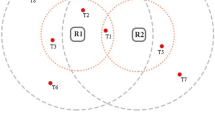Abstract
Transponder collision problem can be significant when a large number of RFID (radio frequency identification) transponders exist in field. Most existing anti-collision algorithms can solve this problem. However, problem arises when all or part of these transponders are having identical UID (unique identification). This paper proposes a new transponder collision control algorithm to overcome overlapping that occurs among transponders with identical UID in RFID large scale deployment (e.g., in a large warehouse), so that the RFID reader can successfully identify the quantity of transponders for each particular UID with high identification accuracy. The proposed anti-collision algorithm adopts a modified version of frequency domain method by adding stochastic delays in time domain. The obtained results show that the proposed method can achieve optimum frequency bandwidth utilization and at the same time poses high identification accuracy (almost 100%) with low identification delay.
Similar content being viewed by others
References
Shepard S. (2005) RFID: Radio frequency identification. McGraw-Hill, New York
Finkenzeller K. (2003) RFID handbook: Fundamentals and applications in contactless smart cards and identification (3rd ed). Wiley, Chichester
Bing B. (2000) Broadband wireless access. Kluwer, Boston
Forouzan B.A. (2003) Data communications and networking (3rd ed). McGraw-Hill, New York
Zhou, S., Luo, Z., Wong, E., Tan, C. J., & Luo, J. (2007). Interconnected RFID reader collision model and its application in reader anti-collision. In IEEE international conference on RFID, Grapevine, Texas, USA (pp. 212–219).
Engels, D. W., & Sarma, S. E. (2002, October). The reader collision problem. In Proceedings of the IEEE international conference on systems, man and cybernetics, Hammamet, Tunisia (Vol. 3, pp. 6).
Leong, K. S., Ng, M. L., & Cole, P. H. (2005, August). The reader collision problem in RFID systems. In Proceedings of the IEEE international symposium on microwave, antenna, propagation and EMC technologies, Beijing (Vol. 1, pp. 658–661).
Hush, D. R., & Wood, C. (1998). Analysis of tree algorithms for RFID arbitration. In Proceedings of the IEEE international symposium on information theory, Cambridge, MA, USA (pp. 107).
Yuan Y., Yang Z., He Z., He J. (2006) Taxonomy and survey of RFID anti-collision protocols. Computer Communications 29: 2150–2166
Su-Ryun, L., Sung-Don, J., & Chae-Woo, L. (2005). An enhanced dynamic framed slotted ALOHA algorithm for RFID tag identification. In The second annual international conference on mobile and ubiquitous systems: Networking and services (MobiQuitous 2005), San Diego, CA, USA (pp. 166–174).
Leong, K. S., Ng, M. L., Grasso, A. R., & Cole, P. H. (2006, January). Synchronization of RFID readers for dense RFID reader environment. In Proceedings of the IEEE international symposium on applications and the internet workshops, Phoenix, Arizona (pp. 48–51).
Reza A. W., Tan K. G. (2009) Objects tracking in a dense reader environment utilizing grids of RFID antenna positioning. International Journal of Electronics 96(12): 1281–1307
Reza A. W., Tan K. G. (2009) Investigation of indoor location sensing via RFID reader network utilizing grid covering algorithm. Journal of Wireless Personal Communications 49(1): 67–80
Tan K. G., Wasif A. R., Tan C. P. (2008) Objects tracking utilizing square grid RFID reader network. Journal of Electromagnetic Waves and Applications 22(1): 27–38
Philips Semiconductors. (2005, January). I.Code1 label ICs protocol air interface, datasheet.
Philips Semiconductors. (2003, January). I.Code SLI smart label IC SL2 ICS20 functional specification, datasheet, from http://www.synometrix.com/I_Code_sli_Data_Sheet.pdf.
Philips Semiconductors. (2004, January). SL2 ICS11 I.Code UID smart label IC functional specification, datasheet, from http://www.advanide.com/datasheets/sl2ics11.pdf.
Penton Media, Inc. (1999). RFID tag reader uses FSK to avoid collisions, from http://www.elecdesign.com/Articles/.
Harald, V. (2002). Efficient object identification with passive RFID tags. In Proceedings of the first international conference on pervasive computing (pp. 98–113). London, UK: Springer.
Kreyszig E. (1999) Advanced engineering mathematics. Wiley, London
Author information
Authors and Affiliations
Corresponding author
Rights and permissions
About this article
Cite this article
Reza, A.W., Geok, T.K., Chia, K.J. et al. RFID Transponder Collision Control Algorithm. Wireless Pers Commun 59, 689–711 (2011). https://doi.org/10.1007/s11277-010-9932-8
Published:
Issue Date:
DOI: https://doi.org/10.1007/s11277-010-9932-8




